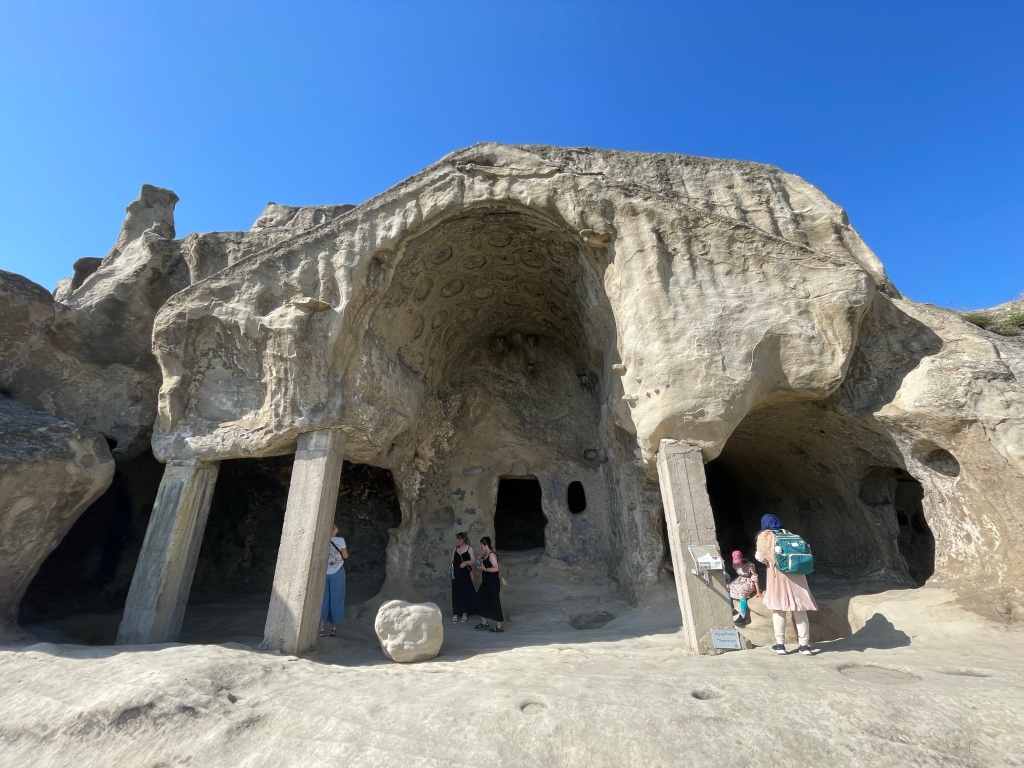
Uplistsikhe Cave Town-Fortress is situated on a rocky massif about 15 km from Gori, Georgia. We stopped to visit this place prior to spending one night in Gori, while being on our way to the Caucasus Mountains.
This Cave Town is also located aside the river Mtkvari and, in addition to the caves, it has a very comprehensive and interesting museum. We learned that the fortress built in these caves is mentioned in chronicles from the I-II millennium B.C., and that Uplistsikhe was an important religious, political and cultural centre in the Hellenistic and the late Antique periods (IV c. B.C. – IV c. A.D.). The town was in its heyday as far back as the 9th -11th centuries and, in 13th century, it was ravaged by Mongols.
Living quarters and premises for communal purposes occupy a cliff territory of almost 8 hectares and are connected by footways. The majority of the caves are devoid of any decorations. The central ensemble, a big hall with coffered tunnel-vaulted ceiling, and the palace complex, is the most interesting one architecturally. The natural rock easily lent itself to various kinds of treatment, making it possible to create complex decorative compositions.
The cave complexes dating to high medieval times usually included a number of small hall-churches beside the dwellings. Archaeological excavations have revealed extraordinary artefacts of different epochs: beautiful golden, silver and bronze jewellery, magnificent samples of ceramics and sculptures.
The place is first mentioned in the VII century in several written sources. Archaeological and architectural monuments are preserved in Uplistsikhe and its surroundings, the oldest of which dates back to the Early Bronze Age and belongs to the Mtkvari-Araksi culture (settlements in Lashetkhevi, Gudabertka, near Gori). The lower layer of Katlanikhevi dates back to the end of the Middle Bronze Age.
While going through this ancient place and its museum, we also learned that the ensemble carved into the Uplistsikhe rock and the settlements grouped around it have come a long way in development. The rock-cut settlement became the residence of the hegemon communities living near Uplistsikhe, and then the tribal union center of “Zena Village” (shida kartli), where the commander of this union (village headman), the Lord sat (hence the name Uplistsikhe). From the early antique period (VI-IV centuries AD) Uplistsikhe was an urban-type settlement, which became a major urban center in the early Hellenistic period (at the end of the IV century AD – III century). The rock-cut settlement became the inner city of the ancient city. From the IV century Uplistsikhe, like some other cities, demoted and only the southern strategic importance remained. During the struggle for the unification of Georgia (IX-X centuries), the weakened fortress-town of Uplistsikhe passed from hand to hand. In the IX-X centuries, Georgian kings, princes of Kakheti and kings of Armenia fought for dominance in Uplistsikhe.
Uplistsikhe gradually lost its significance after the political unification of Georgia (X century). This process was crowned by the liberation of Tbilisi by David Agmashenebeli in 1122.
These are some photos and videos I took while visiting it:














Leave a comment